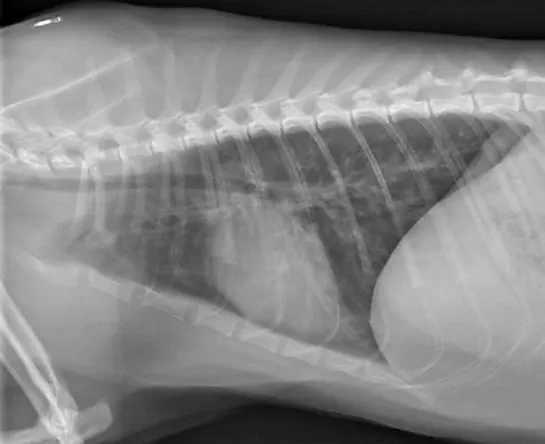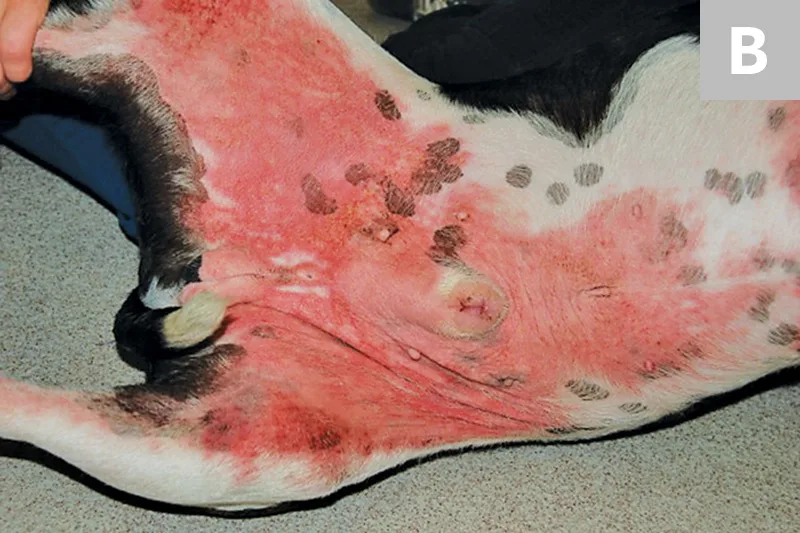Top 5 Indications for Emergency Corticosteroid Therapy
Marie K. Holowaychuk, DVM, DACVECC, Reviving Veterinary Medicine, Calgary, Alberta, Canada

Corticosteroids are used to manage some diseases diagnosed in the emergency room. Depending on the dosage, corticosteroids can replace glucocorticoid activity in patients with adrenal insufficiency, function as anti-inflammatory drugs, or provide immunosuppressive effects.
Corticosteroids can be lifesaving when used appropriately; however, they should be avoided in situations such as head trauma.1 Corticosteroids differ in duration of action and potency, so total daily doses should be adjusted depending on the drug used (Table). For example, dexamethasone has 10 times the potency of prednisone or prednisolone; therefore, the dose of dexamethasone is one-tenth the equivalent dose of prednisone or prednisolone.
Corticosteroid Doses for Emergency Patients
The goal of corticosteroid therapy is to use as much of the drug as is required but as little as possible for as short a duration as possible in order to avoid adverse effects (eg, polyuria, polydipsia, polyphagia, hair loss, weight gain).2 It is also important to ensure that a diagnosis is made before initiating corticosteroid therapy, as it can potentially mask underlying disease.
1. Addisonion Crisis
Addison's disease (ie, hypoadrenocorticism) is typically diagnosed in young female dogs. All breeds can be affected, although some (eg, bearded collie, border terrier, English pointer, standard poodle, Portuguese water dog) appear to be overrepresented.3 Dogs in an Addisonian crisis exhibit signs of cardiovascular collapse, including lethargy, weakness, hypotension, poor peripheral pulses, cool extremities, and prolonged capillary refill time. These are often accompanied by GI signs (eg, vomiting, diarrhea, inappetence, melena, weight loss) and occur because of a deficiency of glucocorticoids normally secreted by the adrenal glands. Concurrent electrolyte abnormalities (eg, hyponatremia, hyperkalemia, sodium:potassium ratio <27:1) can occur when mineralocorticoid deficiency is also present.4
Emergency management of a dog in Addisonian crisis should include rapid IV fluid therapy with isotonic crystalloids (eg, Plasmalyte-A, lactated Ringers solution, 0.9% NaCl) as 20 mL/kg boluses over 15 minutes until hemodynamic stability is achieved (up to 90 mL/kg total). GI protectants and antiemetics can also be provided as supportive care.4 Postadrenocorticotropic-hormone (ACTH) stimulation cortisol results less than 2 µg/dL is standard for diagnosing hypoadrenocorticism, whereas a baseline cortisol greater than 2 µg/dL rules out hypoadrenocorticism.5 If the test cannot be performed in an emergency situation, an anti-inflammatory dose of dexamethasone can be given before performing the ACTH test without affecting results.
Once hypoadrenocorticism is diagnosed, anti-inflammatory (ie, stress) doses of corticosteroids should be administered daily for one week. The dose can then be decreased to physiologic amounts, which require lifelong administration, and used with mineralocorticoid replacement (eg, fludrocortisone, desoxycorticosterone) in dogs with electrolyte abnormalities.
2. Upper Airway Obstruction
Obstructions of the upper airway (ie, nasal cavity, pharynx, larynx, trachea) typically cause respiratory distress, cyanosis, and loud breathing or goose-honking. Dogs may be concurrently hyperthermic because of a reduced ability to pant and dissipate heat.6 Diseases and/or conditions that commonly cause upper airway obstruction include severe allergic reactions (eg, bee stings), brachycephalic obstructive airway syndrome, laryngeal paralysis, and tracheal collapse (Figure 1).

A Yorkshire terrier intubated for emergency treatment for severe tracheal collapse
Emergency management of upper airway obstruction involves administration of supplemental oxygen (via flow-by, mask, or cage) and sedation (eg, butorphanol [0.2-0.4 mg/kg IV/IM] and/or acepromazine [0.01-0.02 mg/kg IV/IM]). In addition, short-term administration of anti-inflammatory doses of corticosteroids can help reduce inflammation and obstruction.7 In severe cases of upper airway obstruction, emergency intubation, or tracheostomy if intubation is not possible, may be necessary.
3. Allergic Airway Disease
Allergic airway disease can result in restriction of the lower airways (ie, bronchi); the most common form is feline asthma.8 Patients with lower airway obstruction typically exhibit tachypnea with expiratory distress (ie, prolonged expiration), coughing, or wheezes; radiographs will indicate a bronchial pattern (Figure 2).

Lateral thoracic radiograph of a cat with severe asthma demonstrating a bronchial pattern characterized by “railway tracks,” “doughnuts,” and hyperinflated lungs
Patients with allergic airway disease can benefit from oxygen and sedation as outlined here for upper airway obstructions. Concurrent administration of an inhalant (eg, albuterol [1-2 puffs q30-60min]) or injectable bronchodilators (eg, terbutaline [0.01-0.05 mg/kg IV/IM/SC] q4-12h) is recommended. In addition, injectable, oral, or inhaled anti-inflammatory doses of corticosteroids are recommended to help reduce small airway inflammation and prevent fibrosis.8
4. Allergic Dermatitis
Allergic dermatitis can occur secondary to atopy, parasites (eg, fleas), food allergy, or contact dermatitis. Patients frequently have overlapping underlying causes and are presented for severe pruritus and erythematous skin lesions (Figure 3). It is important to identify and treat the underlying cause to reduce the risk of recurrence.


A 5-year-old male French bulldog presented for severe pruritus and erythema of the face (A) and abdomen (B), indicating allergic dermatitis secondary to chronic atopy
To reduce pruritus and improve patient comfort while an underlying cause is diagnosed and treated, short-term anti-inflammatory doses of corticosteroids can be beneficial. Although secondary infections are common in animals with allergic dermatitis, use of anti-inflammatory doses of steroids is not precluded in these patients. Allergen avoidance, infection control, antihistamines, and allergen-specific immunotherapy are also important therapies that often must be combined to effectively resolve disease.
5. Immune-Mediated Disease
Patients can be presented for emergency treatment of immune-mediated diseases (eg, immune-mediated hemolytic anemia, immune-mediated thrombocytopenia). These can occur as primary (ie, no known underlying condition) or secondary (ie, identified underlying condition) diseases related to drug administration, infection, or neoplasia.
Dogs with immune-mediated hemolytic anemia are often presented with icterus, dark urine, lethargy, weakness, collapse, and pale or icteric mucous membranes (Figure 4); laboratory findings can include anemia (ie, packed cell volume <30%), sometimes with a positive slide agglutination test. Patients with immune-mediated thrombocytopenia can also be presented with anemia but will often have concurrent hypoproteinemia secondary to hemorrhage and protein loss. These patients also tend to have severe thrombocytopenia (ie, platelets <20 000/µL) with signs of hemorrhage that may include epistaxis, hematuria, melena, hematochezia, petechiae, ecchymoses, hyphema, and/or bleeding from the gums.

Icteric sclerae in a hound dog with immune-mediated hemolytic anemia
If immune-mediated disease is suspected, a complete diagnostic investigation should be performed to rule out any underlying cause. This typically involves infectious disease screening (eg, for tick-borne disease), diagnostic imaging (eg, chest and abdominal radiography, abdominal ultrasonography), and sometimes bone marrow aspirates/biopsies or arthrocentesis.
Once an investigation has been performed and immune-mediated disease diagnosed, administration of immunosuppressive doses of corticosteroids is recommended. Because these are often required long term, it is important to warn owners about adverse effects and the detrimental consequences of abrupt discontinuation of the medication. When possible, long-term corticosteroids should be weaned slowly and only once the condition has been stable for at least one month.
Conclusion
Corticosteroids can be used to manage some diseases diagnosed in the emergency room. When dosed appropriately, these drugs can provide cortisol replacement, reduce inflammation, and allow immunosuppression. The total daily dose varies depending on the corticosteroid used and should be reduced to the lowest possible amount to manage clinical signs and ameliorate side effects.
ACTH = adrenocorticotropic hormone